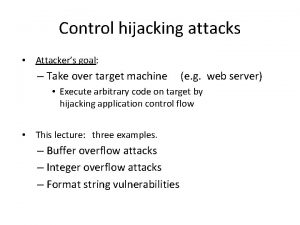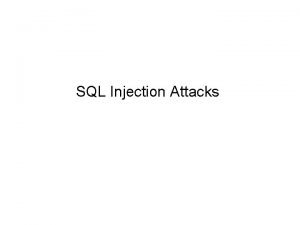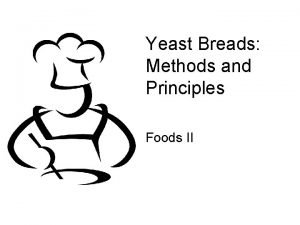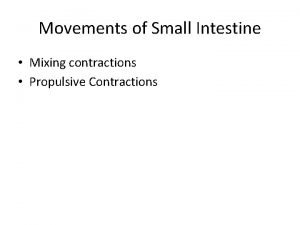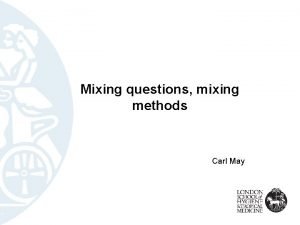An Analysis of Parallel Mixing with Attacker Controlled








![Theorem 1 Pr[s 1 -> s 1] = (1 -0)/((2 -1)) = 1 M Theorem 1 Pr[s 1 -> s 1] = (1 -0)/((2 -1)) = 1 M](https://slidetodoc.com/presentation_image/5a7fd6e10f72fa7e284a3343c30d10d7/image-9.jpg)
![Anonymity Metrics • Anon [Golle and Juels ‘ 04] • Entropy [SD’ 02, DSCP’ Anonymity Metrics • Anon [Golle and Juels ‘ 04] • Entropy [SD’ 02, DSCP’](https://slidetodoc.com/presentation_image/5a7fd6e10f72fa7e284a3343c30d10d7/image-10.jpg)









- Slides: 19

An Analysis of Parallel Mixing with Attacker. Controlled Inputs Nikita Borisov formerly of UC Berkeley

Definitions • “Parallel Mixing” - A latency optimization for synchronous re-encryption mixnets [Golle & Juels 2004] • “Attacker-Controlled Inputs” - Inputs to a mixnet which can be linked to corresponding outputs - Either directly controlled by attackers or discovered through other means • “Analysis” - Low anonymity if most inputs are known - If few inputs are known, anonymity loss can be amplified with repeated mixings

Synchronous Re-encryption Mixes • Messages are mixed by all mix servers • Re-encryption of each message under the same decryption key M 1 M 2 M 3 M 4 Mix 1 M’ 2 M’ 3 M’ 4 Mix 2 M’’ 1 M’’ 2 M’’ 3 M’’ 4

Parallel Mixing Rotation Distribution Rotation M 1 M 2 Mix 1 M 3 M 4 Mix 2

Properties • Initial public permutation to assign inputs to batches • T rotations, followed by 1 distribution, followed by T more rotations • Defends against up to T dishonest mixes • Latency is 2(T+1)*N/M re-encryptions - N - number of messages - M - number of mix servers • Even with T=M-1, faster than conventional cascade with N*M re-encryptions (for M>2)

Attacker-Controlled Inputs M 1 M 2 M 3 M 4 1 Mix 1 Mix 2 2 2 1

Overview • • • Introduction Analysis Methods Analysis Results Multiple-round analysis Open problems Conclusions

Theorem 1 Definitions • (j) = # of known inputs in batch j ( (1) = 1) • (j’) = # of known outputs in batch j’ ( (1) = 1) • (j, j’) = # of known inputs in batch j matching outputs in batch j’ ( (1, 1) = 0) M 1 M 2 M 3 M 4 1 Mix 1 Mix 2 2 2 1
![Theorem 1 Prs 1 s 1 1 02 1 1 M Theorem 1 Pr[s 1 -> s 1] = (1 -0)/((2 -1)) = 1 M](https://slidetodoc.com/presentation_image/5a7fd6e10f72fa7e284a3343c30d10d7/image-9.jpg)
Theorem 1 Pr[s 1 -> s 1] = (1 -0)/((2 -1)) = 1 M 2 M 3 M 4 1 Mix 1 Mix 2 2 2 1
![Anonymity Metrics Anon Golle and Juels 04 Entropy SD 02 DSCP Anonymity Metrics • Anon [Golle and Juels ‘ 04] • Entropy [SD’ 02, DSCP’](https://slidetodoc.com/presentation_image/5a7fd6e10f72fa7e284a3343c30d10d7/image-10.jpg)
Anonymity Metrics • Anon [Golle and Juels ‘ 04] • Entropy [SD’ 02, DSCP’ 02] • Can compute either metric using Theorem 1 - Need to know (j), (j’), and (j, j’) for each j, j’

Scenarios • Given a scenario: - # of known inputs - Distribution of known inputs among input batches - Distribution of known outputs among output batches • We can compute: - (j), (j’), and (j, j’) - Anonymity metrics • What’s a typical scenario? - Distribution of anonymity metrics

Combinatorial Enumeration • Given # of known inputs, enumerate through all scenarios - All initial permutations - All mix shuffle choices • Compute (j), (j’), and (j, j’) for each possibility • Improvements: - Partition states into equivalence classes - Combinatorial enumeration

3 Mixes, 18 Inputs 17311151454831150294756284149883771654705774592 00000000000 possible scenarios

Sampling • Full enumeration still impractical for large systems • Instead, we use sampling: - Given a # of known inputs, simulate a random scenario - Compute (j), (j’), and (j, j’) and anonymity metrics - Repeat • Get a sampled distribution of metrics - Misses the tail of distribution, but we don’t care

1008 Inputs, 900 unknown

1008 inputs, 100 unknown

Multiple-Round Analysis • Anonymity may be short of optimal, but with Anon > 10, who cares? • Consider repeated mixing of the same inputs - Unlikely to happen with e-voting - Likely if parallel mixing used for TCP forwarding • Each mixing is a new, random observation - Reveals new information each time • Over time, input-output correspondence identified w. h. p.

Repeated mixing with 500 unknown inputs • Note: all mixes here are honest!

Conclusions • Parallel mixing reveals information when attackers control some inputs - Big problem if most inputs are controlled - When fewer inputs are known, repeated mixings may still be a problem • This problem exists even if all mixes are honest • Statistical approximations should be checked by simulations
 Example of control hijacking
Example of control hijacking An attacker injects the following sql query blah
An attacker injects the following sql query blah Antigen attacker
Antigen attacker End member mixing analysis
End member mixing analysis Like parallel force system
Like parallel force system The approximate center of a pattern is called
The approximate center of a pattern is called Parallelism rules
Parallelism rules Purdue parallel structure
Purdue parallel structure Parallel structure means using the same pattern of
Parallel structure means using the same pattern of Sipo shift register waveform
Sipo shift register waveform Parallelism definition
Parallelism definition Soft medium dough examples
Soft medium dough examples Mixing in warehousing
Mixing in warehousing Ramco super plaster mixing ratio
Ramco super plaster mixing ratio Stable atmosphere definition
Stable atmosphere definition Mixing of thymol and menthol
Mixing of thymol and menthol Quick breads definition
Quick breads definition Quattromix
Quattromix Herbicide mixing cheat sheet
Herbicide mixing cheat sheet Mixing contractions
Mixing contractions
